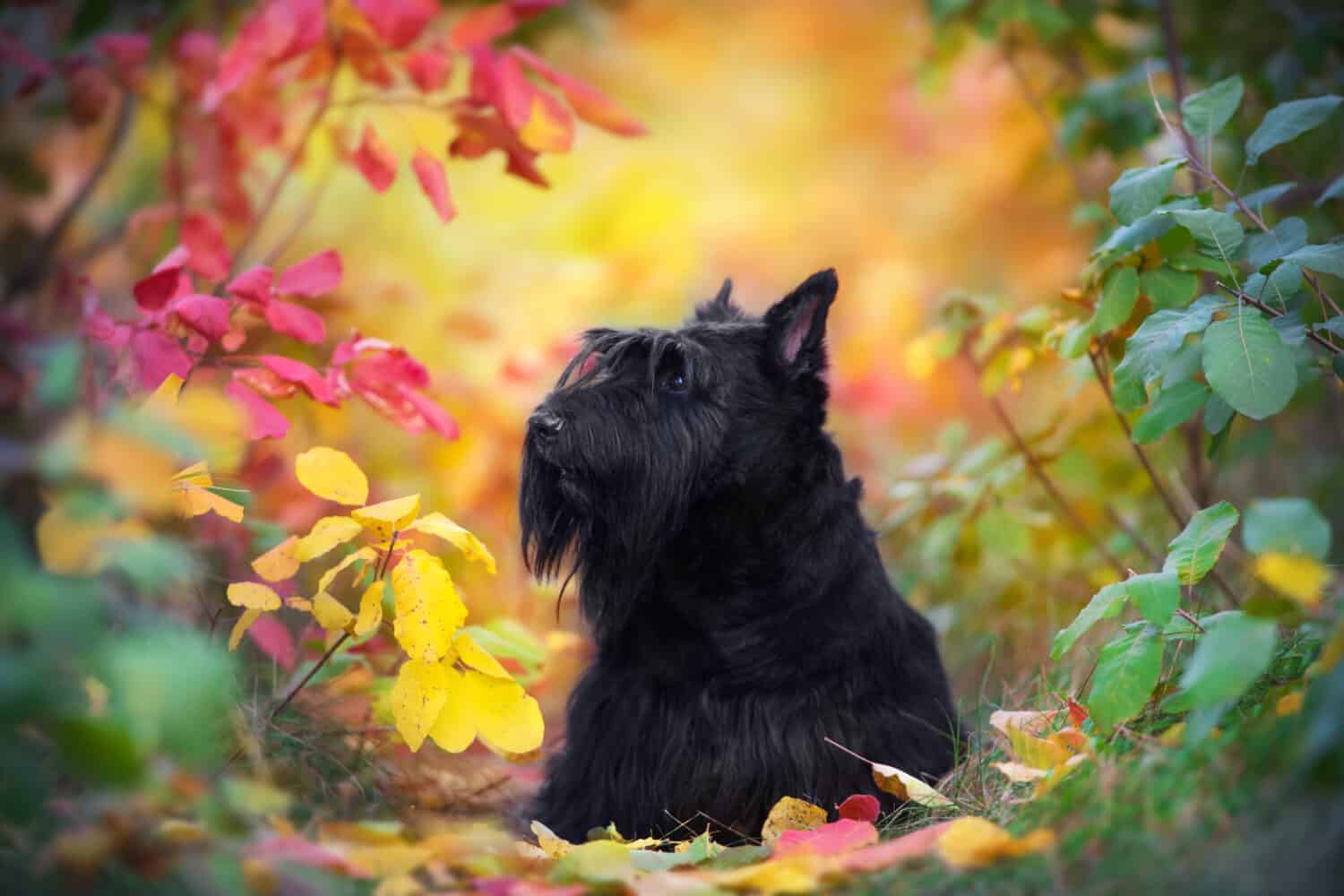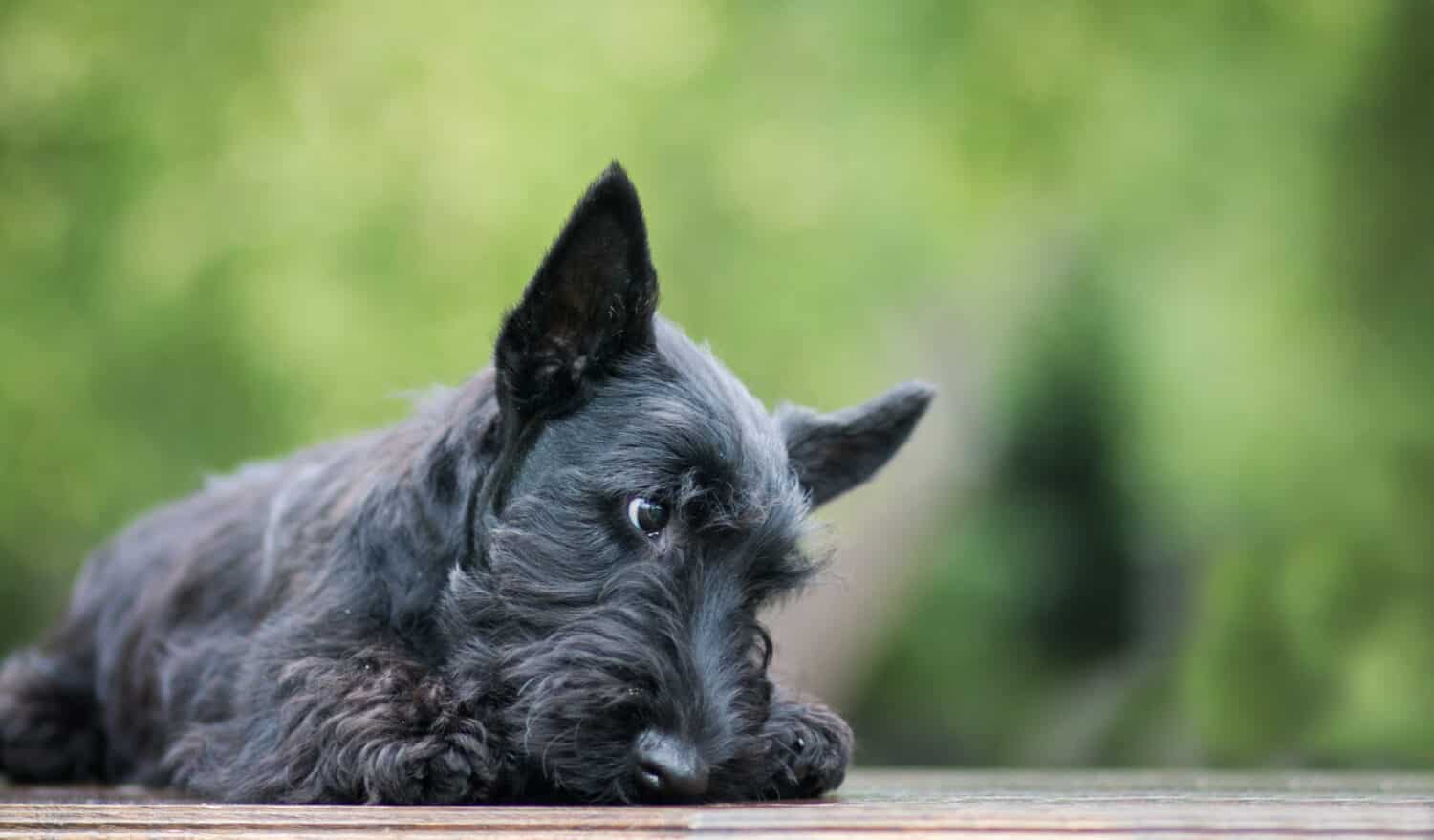Commonly known as the “Scottie,” Scottish terriers are some of the most soulful dogs out there. Many people report that this breed has a uniquely human essence about them. These dogs are highly intelligent and very deeply emotional, making them wonderful companions. Regardless of gender, it is no secret that the Scottish terrier is held in high regard. However, when deciding which gender of Scottish terrier you should welcome into your family, there are some key differences to consider. Today, we’ll discuss five traits that differ between male and female Scottish terriers.
Scottish Terriers: A Brief History

The mascot of Juicy Couture is a Scottie.
©Eve Photography/Shutterstock.com
Scottish terriers have roots that date back to the 1800s, although their origins are difficult to discern. These dogs were originally bred to control populations of otters, foxes, and mice in Scotland. However, it is thought that as many as four types of dogs were considered “Scottish terriers” at the time. According to the American Kennel Club, the so-called “Scotch terrier” known by that name up to the 19th century was something more akin to the current Irish Terrier than a sturdy, low dog like today’s Scottish Terrier.” Each of the different types of Scottish terrier were accepted as such, and therefore their history is hard to trace.
This breed was slow to pick up speed, but since this time, Scottish terriers have become widely popular. This dog took America by storm beginning in the 1930s, and many public figures were known for owning one. People such as Franklin D. Roosevelt, Humphrey Bogart, and Bette Davis were all spotted with this beloved breed. At one point in recent history, this breed was at risk of disappearing. However, since 2020, their popularity has been on the rise once more.
Physical Characteristics

The Scottish terrier Monopoly piece is a favorite among players, only second to the car.
©SubertT/Shutterstock.com
It may be hard to tell the gender of a Scottish terrier at first glance, so don’t get discouraged if this doesn’t come naturally to you. Females have smaller, more sleek bodies whereas males tend to weigh a bit more and look more muscular. Males weigh about 19 to 22 pounds, whereas females weigh about 18 to 20 pounds. Both dogs stand about 11 inches tall. To those who have owned Scottish terriers for many years, identifying their gender by sight may seem easy. However, this is relatively difficult for the untrained eye, as both genders have many similar physical characteristics.
Males have a more voracious appetite when compared to females, and this lends to their larger body structure. Beyond this, the physical characteristics of your Scottie will depend mostly on genetics. Some variations of Scottish terriers may be larger than others naturally. For more information on this, consult directly with your breeder.
Vocalizations

The Scottish terrier is one of the most recognizable breeds and they are popular in many countries.
©Ondrej Prosicky/Shutterstock.com
Both male and female Scottish terriers will have roughly the same level of vocalization. These dogs are known to be very talkative and bark for a large variety of reasons. They could be happy or excited, or warning you about a visitor at the door. Males are slightly more excitable, and in turn, they may be slightly noisier. Their playful nature and energetic personality tend to lead to lot of barking. This is often positive, and they’re likely making so much noise because they’re having so much fun.
Females have a more relaxed attitude and only become highly vocal if they feel it is totally necessary. They’re a bit more low-energy and are less motivated to play constantly. If your female Scottie barks, you may want to perk up and investigate, as she could be telling you something. Both genders will be more vocal if left intact, which we’ll talk more about later.
Behavioral Differences

This breed is tiny, but very strong for their size.
©Tatiana KuzinaSatu/Shutterstock.com
The easiest way to discern the gender of a Scottish terrier is to observe their behavior. Although all Scotties are generally affectionate and well-tempered, males may exhibit aggressive behavior around other male dogs. They tend to have more energy and are slightly less responsive to training. On the other hand, male Scottish terriers are more likely to be highly affectionate and attention-seeking. Males are usually big snugglers and love to curl up on the couch just as much as they love to play. Female Scottish terriers are more docile and relaxed than males. They are open and curious about strangers and spread their love equally to all family members. They’re easier to train and have the ability to stay focused for longer periods of time.
Both males and females get along better with the opposite gender. If you already have a dog at home, try to get the opposite sex Scottish terrier. Neutering and spaying will also affect the behavior of your Scotties. Intact males have the tendency to become more aggressive in general, and more difficult to contain. They will be highly motivated to breed and may dart out the door the first chance they get. Intact females will enter heat periodically, and if she does have puppies, she may develop some protective aggression over them. Scotties who are neutered or spayed won’t display these behaviors.
Response to Training

Scottish terriers were originally bred as hunting dogs.
©Kwadrat/Shutterstock.com
Scottish terriers may be more difficult to train when compared to other dog breeds. However, there are some strategies that will help you keep them on task. Male Scotties are highly energetic and want to play constantly. This is especially true while they’re still puppies. Despite this, it is important to begin training your Scottie straight after bringing them home. Their brains develop quickly, and it is important to feed them information while they’re young. If you find that your male Scottie is having trouble staying focused, try keeping snacks on hand. This may prove helpful in maintaining their attention.
Females may be less inclined by treats. Although some female Scotties will respond well to food, it is more often the case that they prefer words of affirmation. Try repeating the same positive phrase over and over in an elevated pitch of voice, such as “good girl.” She will begin to associate this with the action you’d like her to do.
Health Considerations for Scottish Terriers Depending on Their Gender

Scottish terriers can be stubborn, but they are incredibly loyal and affectionate.
©Eve Photography/Shutterstock.com
As always, there are certain diseases that each gender will be more susceptible to than the other. For females, ovarian cancer is a primary health concern whereas male Scottish terriers will be at risk for testicular cancer. However, the risk of these two diseases is mitigated by neutering or spaying your Scottish terrier while they are young. This procedure is highly recommended for dogs not being used for breeding, as it is correlated with better overall lifelong health.
Both genders of Scottish terrier will be vulnerable to the same few diseases. Joint issues, autoimmune disorders, and allergies are not uncommon for dogs of this breed. However, the risks are highly mitigated by purchasing your Scottie from a reputable breeder. Genetic disorders often run rampant in unregulated breeding operations, such as puppy mills. Although they may be cheaper, you will likely pay in the long run through vet bills and a guilty conscience.
Final Thoughts
If you have male dogs in the home already, a female Scottish terrier may be better suited for you. However, if you have females at home, consider adopting a male Scottish terrier. If this is your first dog, either gender is an excellent choice. Although there may be slight variations between the two genders, both males and females share the most important trait: loyalty. Beyond this, it’s a matter of personal preference when deciding which gender would best fit the dynamics of your home.
The photo featured at the top of this post is © Ondrej Prosicky/Shutterstock.com
Ready to discover the top 10 cutest dog breeds in the entire world?
How about the fastest dogs, the largest dogs and those that are -- quite frankly -- just the kindest dogs on the planet? Each day, AZ Animals sends out lists just like this to our thousands of email subscribers. And the best part? It's FREE. Join today by entering your email below.
Thank you for reading! Have some feedback for us? Contact the AZ Animals editorial team.







